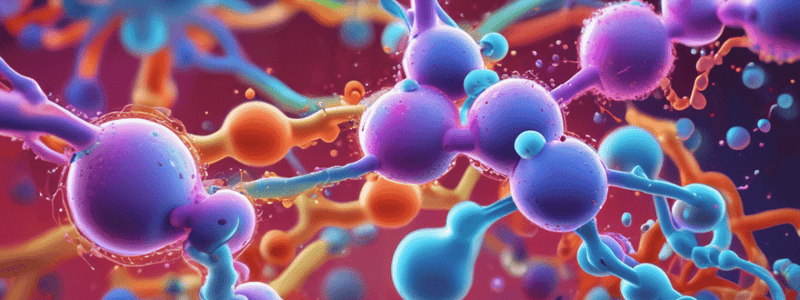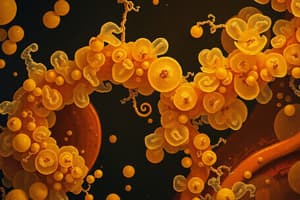Podcast
Questions and Answers
What is a potential issue with inserting 'unnatural' glycosylation sites?
What is a potential issue with inserting 'unnatural' glycosylation sites?
- They are more reactive than natural glycosylation sites
- They may not be recognized properly by the glycosylation machinery (correct)
- They require a longer spacer region than native sites
- They always result in successful glycosylation
Why might N-glycosylation not occur if the glycosylation site is too close to the membrane?
Why might N-glycosylation not occur if the glycosylation site is too close to the membrane?
- Excessive interaction with membrane proteins
- Inhibition of enzyme activity near the membrane
- Lack of proper recognition by the glycosylation machinery (correct)
- Increased reactivity near the membrane
What characteristic makes cysteinyl residues suitable for site-directed mutagenesis?
What characteristic makes cysteinyl residues suitable for site-directed mutagenesis?
- Inability to be incorporated into proteins
- High reactivity due to free thiol groups (correct)
- Resistance to labeling with maleimide derivative
- Low reactivity and stability in proteins
Why might endogenous cysteines need to be knocked out before introducing new cysteines by mutagenesis?
Why might endogenous cysteines need to be knocked out before introducing new cysteines by mutagenesis?
How can cysteine mutagenesis be used in protein engineering?
How can cysteine mutagenesis be used in protein engineering?
Which of the following techniques is used to identify the location of a protein tag or loop?
Which of the following techniques is used to identify the location of a protein tag or loop?
What is the purpose of introducing a glycosylation site (Asn-X-Ser/Thr motif) into a protein?
What is the purpose of introducing a glycosylation site (Asn-X-Ser/Thr motif) into a protein?
How can the presence of glycosylation at an introduced site be detected?
How can the presence of glycosylation at an introduced site be detected?
What is the purpose of site-directed mutagenesis in the context of determining the topology of a membrane protein?
What is the purpose of site-directed mutagenesis in the context of determining the topology of a membrane protein?
What is the purpose of using thiol-specific reagents in the study of membrane protein topology?
What is the purpose of using thiol-specific reagents in the study of membrane protein topology?
Which of the following statements about N-glycanase is correct?
Which of the following statements about N-glycanase is correct?
In cysteine mutagenesis, what is the primary purpose of replacing naturally occurring cysteine residues with alanine residues?
In cysteine mutagenesis, what is the primary purpose of replacing naturally occurring cysteine residues with alanine residues?
Which of the following statements accurately describes the use of membrane-permeant and membrane-impermeant maleimide reagents in cysteine mutagenesis?
Which of the following statements accurately describes the use of membrane-permeant and membrane-impermeant maleimide reagents in cysteine mutagenesis?
What is a potential limitation of cysteine mutagenesis that should be considered when interpreting the results?
What is a potential limitation of cysteine mutagenesis that should be considered when interpreting the results?
In the context of glycoprotein engineering, what is the significance of introducing cysteine residues at specific locations?
In the context of glycoprotein engineering, what is the significance of introducing cysteine residues at specific locations?
Which of the following statements is true regarding the use of cysteine mutagenesis in combination with thiol-specific reagents?
Which of the following statements is true regarding the use of cysteine mutagenesis in combination with thiol-specific reagents?
In the context of site-directed mutagenesis, what is the purpose of introducing cysteine residues at specific locations within a protein?
In the context of site-directed mutagenesis, what is the purpose of introducing cysteine residues at specific locations within a protein?
Flashcards
Potential issue with unnatural glycosylation sites
Potential issue with unnatural glycosylation sites
Unnatural glycosylation sites might not be recognized by the cellular glycosylation machinery.
N-glycosylation hindered by membrane proximity
N-glycosylation hindered by membrane proximity
If the glycosylation site is too close to the cell membrane, the glycosylation machinery may not access it.
Cysteine suitability for mutagenesis
Cysteine suitability for mutagenesis
Cysteine residues are good for site-directed mutagenesis due to their highly reactive free thiol groups.
Knocking out endogenous cysteines
Knocking out endogenous cysteines
Signup and view all the flashcards
Cysteine mutagenesis in protein engineering
Cysteine mutagenesis in protein engineering
Signup and view all the flashcards
Protein tag/loop location technique
Protein tag/loop location technique
Signup and view all the flashcards
Purpose of introducing glycosylation site
Purpose of introducing glycosylation site
Signup and view all the flashcards
Detecting glycosylation
Detecting glycosylation
Signup and view all the flashcards
Site-directed mutagenesis for membrane protein topology
Site-directed mutagenesis for membrane protein topology
Signup and view all the flashcards
Thiol-specific reagents in membrane protein topology
Thiol-specific reagents in membrane protein topology
Signup and view all the flashcards
N-glycanase function
N-glycanase function
Signup and view all the flashcards
Cysteine replacement with alanine
Cysteine replacement with alanine
Signup and view all the flashcards
Membrane-permeant/impermeant maleimides
Membrane-permeant/impermeant maleimides
Signup and view all the flashcards
Limitation of cysteine mutagenesis
Limitation of cysteine mutagenesis
Signup and view all the flashcards
Cysteine introduction in glycoprotein engineering
Cysteine introduction in glycoprotein engineering
Signup and view all the flashcards
Cysteine mutagenesis and thiol-specific reagents
Cysteine mutagenesis and thiol-specific reagents
Signup and view all the flashcards
Purpose of cysteine introduction in mutagenesis
Purpose of cysteine introduction in mutagenesis
Signup and view all the flashcards




